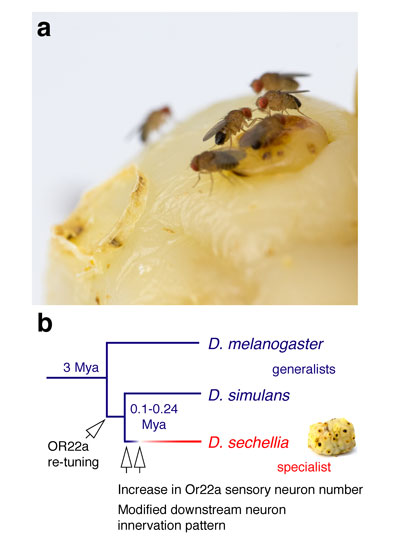Animals exhibit extraordinarily diverse behaviours to prosper in distinct environments. Little is known about the genetic and neural basis of how species-specific behaviours evolve. Drosophilid flies offer a powerful model system to address this problem: we know much about the neurobiology of the laboratory model D. melanogaster and closely-related drosophilids have very different ecologies and behavioural programmes. In our study, we exported D. melanogaster’s neurogenetic “toolbox” to two closely-related species, D. simulans and D. sechellia (Figure 1). Like D. melanogaster, D. simulans is a cosmopolitan food generalist, while D. sechellia, endemic to the Seychelles islands, feeds and lives on a single host, the ripe “noni” fruit of the Morinda citrifolia shrub. By comparing these three drosophilid species, we identified causal changes in the olfactory system of D. sechellia that led to its unique ecological adaptation.

Figure: a: D. sechellia flies on their host fruit Morinda citrifolia (noni). b: D. sechellia shares recent last common ancestors with the ecological generalists D. melanogaster and D. simulans (Mya, million years ago). Within the olfactory system of D. sechellia, the odorant receptor Or22a has acquired novel odour-response properties, the number of Or22a-expressing sensory neurons has increased three-fold, and a downstream interneuron exhibits new innervation properties. Together, these adaptations may promote this species’ high attraction towards noni fruit. Photo credit: Kaan Mika.
We first used behavioural assays to show that D. sechellia displays increased olfactory attraction towards noni compared to D. melanogaster and D. simulans at both long- and short-range in the laboratory. Following chemical analysis of noni fruit, we identified olfactory channels in D. sechellia detecting this fruit’s odours through calcium imaging and electrophysiological recordings. Silencing individual olfactory channels via genetic targeting of olfactory receptor genes in D. sechellia revealed that some channels are important for short-range odour location while others, notably the Odorant receptor 22a (Or22a), are essential for detection of the odour source from a distance.
Or22a is very specifically and sensitively tuned towards the detection of noni-derived esters in D. sechellia compared to D. melanogaster. By structure-function dissection of D. melanogaster and D. sechellia OR22a, we identified key amino acid changes that define differences in odour response properties of these two receptors. Moreover, through receptor allele swap experiments between these drosophilids, we demonstrated the importance of these molecular changes for conferring high attraction of D. sechellia towards noni. Circuit tracing tools introduced into D. sechellia allowed us to compare the circuit architecture of this olfactory channel between species: we found this species has a three-fold increase in the number of sensory neurons expressing Or22a, as well as a novel branching pattern of downstream interneurons in a brain area controlling innate behaviours.
Together, our work establishes D. sechellia as a powerful neurogenetic model system, defines a causal relationship between olfactory receptor tuning and species-specific olfactory attraction, and reveals that changes in olfactory signal processing in the brain also contribute to its unique host-attraction behaviour. Future work can exploit this model to understand more deeply the molecular and neuronal basis of how olfactory – and other – behaviours have adapted to allow this fly to thrive in its unique ecological niche.


































